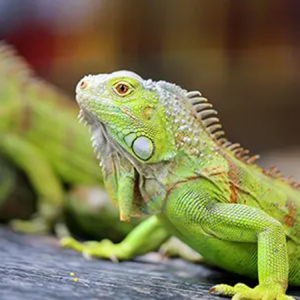Green Iguana

Scientific Name: Iguana iguana
IUCN (Red List) Status: Least Concern (LC)
The green iguana is a large lizard. Adults typically grow to 1.2 to 1.7 m in length from head to tail. As in all iguanas, the tail comprises much of this length, and the snout-to-vent length of most green iguanas is 30 to 42 cm. A typical adult male weighs around 4 kg while the smaller adult female typically weighs 1.2 to 3 kg. A few large males can reach or exceed 8 kg in weight and 2 m long. Some specimens have even reportedly been measured at a body weight of greater than 9.1 kg.
Habitat: Forest. In contrast to the majority of iguana species, Common Green Iguanas have colonized humid tropical rainforests and can be exclusively arboreal, descending to the ground principally for nesting. This species also inhabits other types of habitat beyond tropical rainforest, including dry forest, gallery forest, savannahs with few trees, and even xeric islands with exclusively shrub vegetation.
Animal Location: South American Forest
Diet: Green Iguana is one of the few generalist herbivores of tropical forest canopies. but even so, there is evidence they prefer to feed on certain plant species, not necessarily the most abundant. Consumption of snails and insects that occur on vegetation is probably incidental
Reproduction: Descending to the ground principally for nesting.. In areas where it has been documented, the phenology of this iguana’s reproductive cycle is correlated tightly to the tropical wet and dry seasons. Males establish reproductive territories at the beginning of the dry season and females lay their eggs during a restricted period in the middle of this season, so that eggs begin hatching near the onset of the rainy season, a time when new leaves are abundant and easier for neonates to digest . Clutch sizes vary directly with body size, ranging from nine to 71 eggs.


